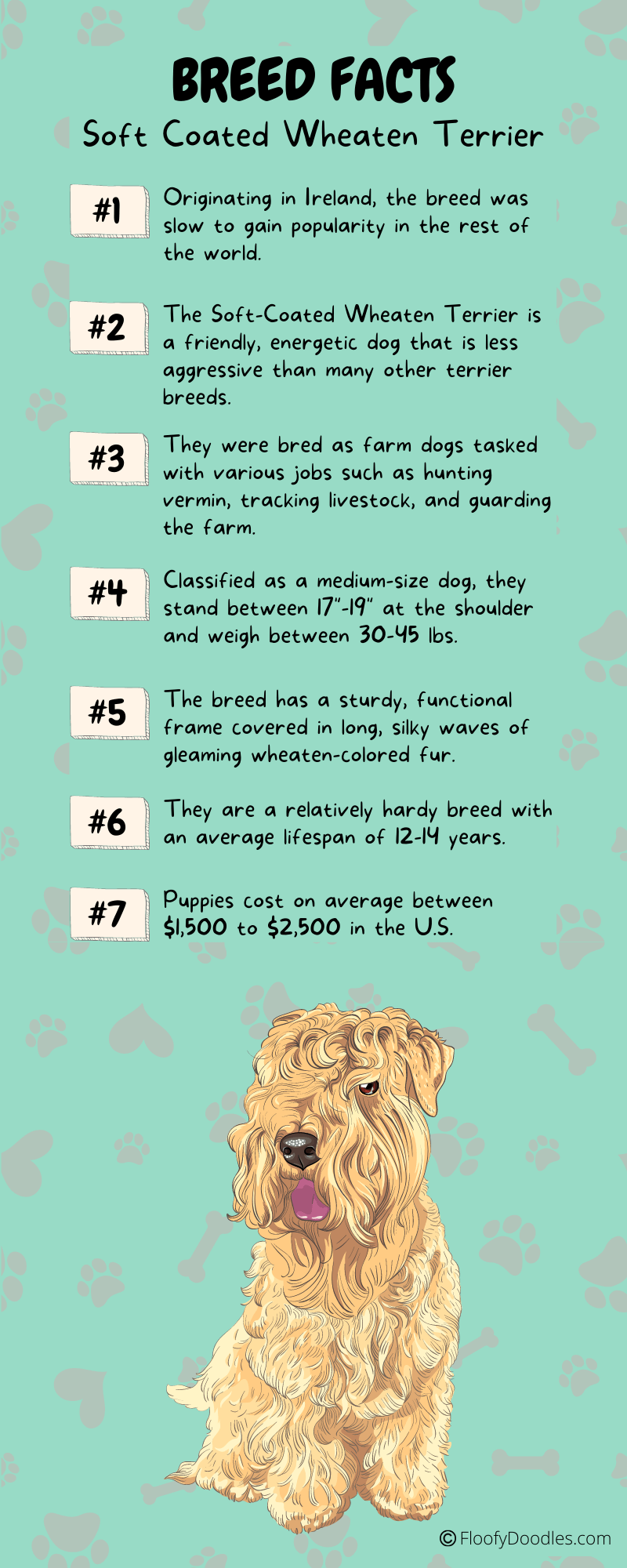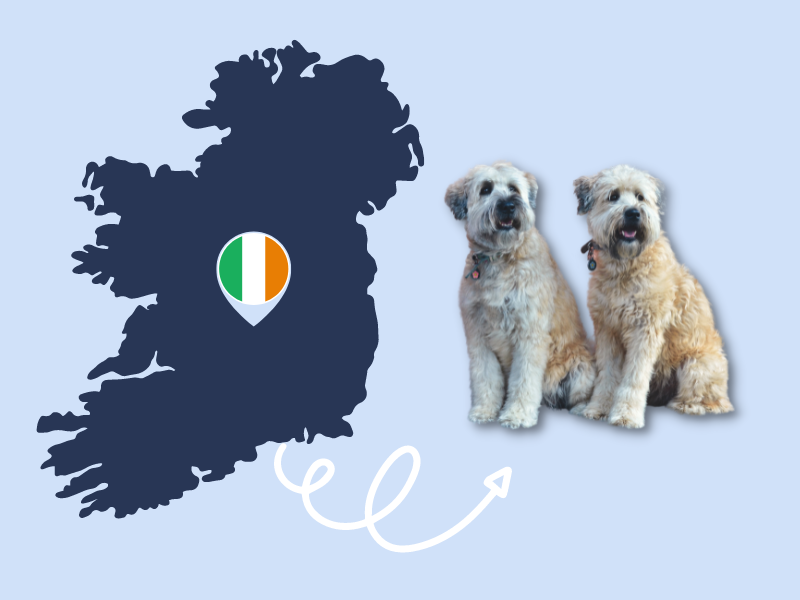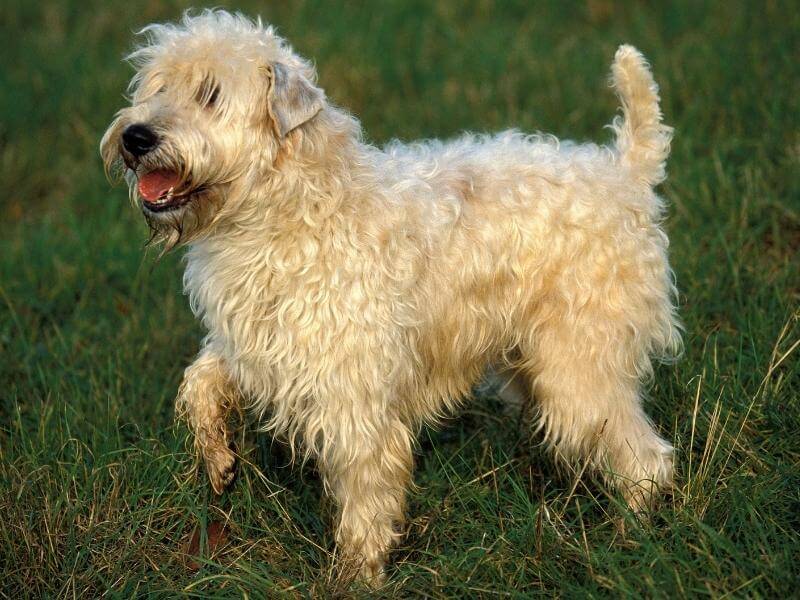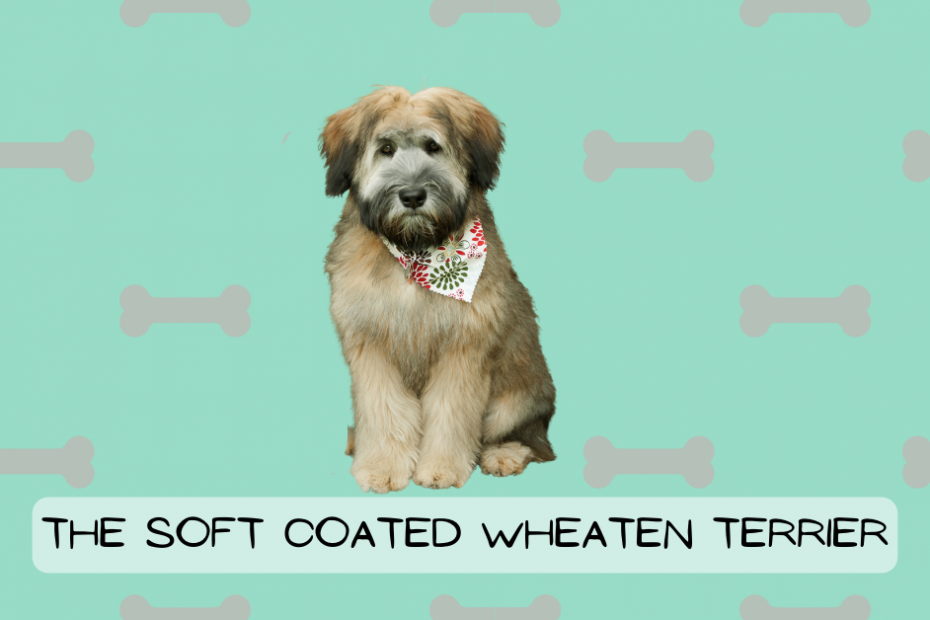Are you curious about the Soft Coated Wheaten Terrier? Are you thinking of adding one to your family and wanting to learn more about them?
Nowadays there is just so much information out there. It makes it nearly impossible to figure out what’s right and what’s wrong.
Well, look no further. This comprehensive guide will give you more than enough information about the Soft Coated Wheaten Terrier dog breed.
Breed Overview
Here is a list of key points to summarize the Soft-Coated Wheaten Terrier.

Origin
Although the exact origins and development of the Soft-Coated Wheaten Terrier have been lost to the annals of time, this has not stopped the Irish people from reveling in the folklore origin story of the Soft-Coated Wheaten Terrier.
Irish storytellers speak of a blue dog who, following the 1588 defeat of the Spanish Armada, in a desperate bid to survive, abandoned the Spanish ship sinking in Tralee Bay. Despite violent storms, the courageous dog made it to shore.
This dog, who was said to be filled with the “luck of the Irish,” was a prolific breeder who sired numerous litters with the native terriers. The resulting puppies were the ancestors of the modern Soft-Coated Wheaten Terrier, Kerry Blue Terrier, and Irish Terrier.
There are no documents that can provide objective proof of this origin story. Still, it makes for a whimsical fireside tale that matches the quirky nature of the Soft-Coated Wheaten Terrier.
Soft-Coated Wheaten Terriers were bred to be an all purpose farm dog. They were often called the “poor man’s dog”. Below is a list of common farm chores that Soft-Coated Wheaten Terriers assisted with:
- Herding and guarding sheep or other livestock.
- Killing vermin and keeping the farm and household free from pests, e.g., rats and mice.
- Alerting their family to intruders.
- Scenting and tracking game and lost livestock.
- Hunting and bringing down small game for their owners.
- Providing companionship and warmth to their humans.
- Assisting with kitchen chores, e.g., turning the spit.
How Hardship Shaped The Breed
The Soft-Coated Wheaten Terrier was developed in a time when people could not and would not nurse sickly or weak dogs. It was survival of the fittest. Soft-Coated Wheaten Terriers were whelped in barns, haylofts, and stables.

Although this breeding method was harsh and resulted in many dogs failing to reach adulthood, the product was a hardy dog who was not fussy about food and could easily tolerate the extremes of Irish weather.
These dogs are a product of their time and a testimony to the resilience of the Irish people.
History Of Soft-Coated Wheaten Terriers
Before the 17th century, the British “Law of the Forests” was introduced. The “Law of the Forest” was a collection of laws, bylaws, and regulations related to activities and actions occurring within the Royal Forests.
One of the rules enforced pertained to the size, breed, and value of dogs that tenant farmers and fishermen could legally own.
Poor tenant farmers and fishermen were not allowed to own any dogs that met the following conditions:
- Cost more than £5.00 (which equates to around $430 USD today)
- Were taller than 19″
- Had undocked tails
- Were purebred hounds, beagles, or spaniels
Although these laws were designed to divide the “haves” from the “have nots,” the one positive outcome was a rapid rise in the popularity of the Soft-Coated Wheaten Terriers amongst the Irish people.
As a terrier breed, standing below 19” and costing less than £5.00 (now they cost quite a bit more), the hardy Soft-Coated Wheaten Terrier was the ideal “legal” dog for poor Irish farmers.
Official Recognition of The Breed
However, the popularity of the Soft-Coated Wheaten Terrier did not last. The Soft-Coated Wheaten Terrier was pushed to the brink of extinction in the early 20th century. Thankfully, fate had other plans for the tenacious terrier.
During field trials featuring various terrier breeds, the outstanding performance of the Soft-Coated Wheaten Terrier caught the attention of Dr. Gerard J. Pierse. Together with Mr. Patrick Blake and a few other influential individuals, Dr. Pierse decided to save this rare breed.
Despite a long, hard struggle, Dr. Pierse convinced the Irish Kennel Club to recognize the Irish Soft-Coated Wheaten Terrier as a distinct breed in 1937. In August 1938, the breed was displayed for the first time in a separate breed class dedicated to Soft-Coated Wheaten Terriers.

However, the battle to get the Soft-Coated Wheaten Terrier recognized as a separate terrier breed did not end there. After their registration with the Irish Kennel Club, Soft-Coated Wheaten Terriers were exported to Britain (1939) and America (1946).
The breed was quickly established in Britain and was granted official breed status in 1943. However, their acceptance into the American Kennel Club was not smooth sailing.
Despite seven puppies arriving in the USA in 1946, the breed failed to achieve breed recognition. In 1957, two families fell in love with the charming Soft-Coated Wheaten Terrier and began campaigning for American Kennel Club (AKC) breed recognition.
In 1962, the Soft-Coated Wheaten Terrier Club of America (SCWTCA) was formed. 26 years after they arrived in the United States, the AKC officially recognized the breed on May 1st, 1973.
Temperament
I have lived with terriers my entire life. From two Airedale Terriers to a Welsh Terrier, I have seen my fair share of their sass, exuberance, and hysterical stubbornness.
Wheatens share that terrier-silliness and are too smart for their own good.
For example, just watch this compilation video of Wheatens being goofballs.
[lyte id=’6N8cIQQAKVE’ /]
Although the Soft-Coated Wheaten Terrier is classified as part of the terrier group, they differ somewhat from the typical “terrier” temperament.
Despite most terrier breeds being on the smaller side, they rarely back down from a threat and can be instigators in a dog fight. The Soft-Coated Wheaten Terrier never got this memo!
Its steady temperament and gregarious nature give the Soft-Coated Wheaten Terrier character. Rather than looking for a fight, the gentle Soft-Coated Wheaten Terrier is more interested in making friends!

Energy
The Soft-Coated Wheaten Terrier has moderate to high energy levels. Although not on the same (manic) energy level as a Border Collie or Malinois, these dogs are no couch potatoes! Wheatens need plenty of exercise and mental stimulation to stay balanced and happy.
In the past, several Soft-Coated Wheaten Terriers were successfully trained as gundogs. However, the modern Soft-Coated Wheaten Terrier has lost much of these sporting instincts.
Although the Soft-Coated Wheaten Terrier is more of a lover than a fighter, they have retained the terrier’s independent nature. This breed can be stubborn to train; however, even novice dog owners can successfully train their Soft-Coated Wheaten Terrier with time and persistence.
Noise Sensitivity
Recent studies (March 2020; April 2020) have found Soft-Coated Wheaten Terriers to show a higher prevalence of noise sensitivity than many other dog breeds.
A 2018 study published in the Journal of “Veterinary Behaviour Early Career Scientist Award in Behavioural Genetics” found significant associations between the SNPs in exon 2 of the Dopamine Receptor 2 Gene and noise reactivity in Soft-Coated Wheaten Terriers.
These findings prove that noise sensitivity is hereditary and may run in specific family lines. The AKC notes that extreme timidity or aggressiveness are severe faults, and dogs displaying these characteristics should not be used as breeding animals.
Size
The UK Kennel Club classifies the Soft-Coated Wheaten Terrier as a medium-sized dog breed, making them the perfect size for most households.
Although most breed registries classify the Soft-Coated Wheaten Terrier as a medium-size dog, there are a few differences in the preferred height and weight of these dogs according to the breed standards described in different countries.
Weight
The UK-bred Soft-Coated Wheaten Terriers tend to be slightly heavier dogs than their American counterparts.
The AKC Soft-Coated Wheaten Terrier breed standard states that males should weigh between 35 lbs to 40 lbs (15.9-18.1 kgs) and females 30 lbs to 35 lbs (13.6-15.9 kgs). In contrast, the UK Kennel Club states that male Soft-Coated Wheaten Terriers should weigh between 35 lbs to 45 lbs (16-20.5 kgs).
The UK Kennel Club does not specify the ideal weight range for female Soft-Coated Wheaten Terriers except that they should weigh less than the males.
Height
According to the AKC, male Soft-Coated Wheaten Terriers should stand between 18” to 19” (45 cm to 48 cm) at the wither and females 17” to 18” (43 cm to 45 cm). The ideal height for a male Soft-Coated Wheaten Terrier is 18.5″ (47 cm), and for a female is 17.5″ (44 cm).
The UK Kennel Club permits dogs to be 0.5″ (1.27 cm) taller than American-bred Soft-Coated Wheaten Terriers. Male Soft-Coated Wheaten Terriers bred in the UK are required to stand between 18″ to 19.5″ (46 cm to 49 cm) at the wither.
No height range is specified for female Soft-Coated Wheaten Terriers in the UK breed standard, although the UK Kennel Club states that females should be shorter than their male counterparts.
Breed Characteristics

Appearance
The guiding principle behind a Soft-Coated Wheaten Terrier’s appearance is functionality. These dogs were required to do numerous jobs and thus needed a robust, athletic conformation to support their endeavors.
The Soft-Coated Wheaten Terrier is a well-proportioned dog, built along moderate lines and showing no extremes in conformation type, e.g., excessively slender build, sloped back, or flattened skull and nose.
The stocky build of the Soft-Coated Wheaten Terrier should be well-muscled, although this is not always apparent at first sight. The rippling waves of the Soft-Coated Wheaten Terrier’s coat can disguise the power and athletic prowess of the Soft-Coated Wheaten Terrier.
The illusion of softness is so prevalent that the AKC likens the Soft-Coated Wheaten Terrier’s conformation to a velvet-covered iron fist.

Coat Colors
A distinguishing trait of the Soft-Coated Wheaten Terrier is their coat; both the color and texture are referenced in the breed’s name. Depending on which breed registry you speak to, you may be told that one to three colors are permissible in Soft-Coated Wheaten Terriers.
The UK Kennel Club permits blonde, brown, and wheaten-colored dogs, whereas the AKC only permits shades of wheaten.
Soft-Coated Wheaten Terriers will often go through several color changes throughout their life. Puppies are usually born a darker color, which lightens to a pale gold as a juvenile. The color of mature dogs is often a deeper, richer color than the color seen in juvenile Soft-Coated Wheaten Terriers.
Coat Type
The Soft-Coated Wheaten Terriers coat is a long, single-layer coat that covers the dog’s entire body.
The ideal adult coat should have a soft, silky texture with a gentle wave pattern. Puppies and Juveniles are easily identified due to their short, fluffy coat, which do not resemble the elegance of the adult’s coat.
Typically, dogs only come into their adult, silky coat between 18 months to 2 years.
Variation in Coat Types
There are three coat types:
- Irish Coat
- American Coat
- Heavy Irish Coat
The Irish coat is slightly thinner and silkier than the American coat type and is considered a more accurate representation of the original Soft-Coated Wheaten Terrier.
The American coat is often described as Bouffant and requires the most grooming. Unlike the Irish coat type, these dogs are well received in American and Canadian show rings.
The last coat is the middle ground between the American and Irish coats and is created by crossing dogs featuring the first two coat types.

Do Soft-Coated Wheaten Terriers Shed A Lot?
Unlike double-coated dogs, the silky single-layered coat of the Soft-Coated Wheaten Terrier is considered a low-shedding coat type.
According to the Soft-Coated Wheaten Terrier Society of Great Britain, there are no seasonal variations in the texture, density, or color of an adult Soft-Coated Wheaten Terrier’s coat. The lack of variation means that owners will not struggle with a heavily shedding dog during changing seasons.
Are Soft-Coated Wheaten Terriers Hypoallergenic?
Many breeders and enthusiasts of the Soft-Coated Wheaten Terrier claim that the breed is hypoallergenic and can safely coexist with a person who suffers from a dog allergy. However, this claim may not be accurate.
People with a dog allergy tend to be allergic to proteins produced in the dog’s skin, internal organs, tongue, and glands and not to the dog’s hair.
A 2011 review study compiled the results of 12 primary studies referencing Soft-Coated Wheaten Terriers. Regardless of the measurement used, Soft-Coated Wheaten Terriers were not more hypoallergenic than other dog breeds.
A 2012 study found that dogs marketed as hypoallergenic had slightly HIGHER levels of Canis Familiaris 1 (allergen), although the study did not reference Soft-Coated Wheaten Terriers specifically.
Although the scientific community has been unable to verify the claims of the Soft-Coated Wheaten Terriers hypoallergenic status, anecdotal reports continue to support the Soft-Coated Wheaten Terrier as a hypoallergenic breed.
It is advisable if you or someone else in your family is allergic to dogs that you go and visit a good breeder before committing to buying a puppy. In my opinion, I would avoid looking for a puppy in a pet store. Focus your effort on finding a reputable breeder and it will pay off in the long run.
The low shedding nature of the Soft-Coated Wheaten Terrier minimizes dust build-up in the home and can be a good match for people suffering from environmental allergies.
How To Groom A Soft-Coated Wheaten Terrier
Grooming a Soft-Coated Wheaten Terrier is not for the faint-hearted. These dogs have a single coat that needs to be intensively groomed each day.
A Soft-Coated Wheaten Terrier’s coat is prone to matting, and something as simple as playing in the autumn leaves can leave Soft-Coated Wheaten Terriers with enormous mats unless the dog is groomed daily.
To groom a Soft-Coated Wheaten Terrier, start with a pin or slicker brush. These brushes will help remove all the loose hair, mud, twigs, and other objects caught in the dog’s coat. Once you have finished with the pin brush, you can switch to a fine-tooth comb.
If you come across any mats while grooming the Soft-Coated Wheaten Terrier, you can gently pick them apart with your fingers or comb. Never cut out a matt as this will ruin the line of a Soft-Coated Wheaten Terrier’s coat.
Soft-Coated Wheaten Terriers should be professionally groomed every 4 to 6 weeks.
How to Brush A Soft-Coated Wheaten Terrier
Brushing a Soft-Coated Wheaten Terrier is an art.
When brushing a Soft-Coated Wheaten Terrier, it is best to work through the coat section by section. The smaller the area you brush, the easier the brush will pass through the hair. A pain-free brushing technique with Soft-Coated Wheaten Terriers is to use line-brushing.
In line-brushing, the hand not holding the brush pushes a section of the hair up and away from the natural hairline. The hair below the hand is brushed. Once the hair is smooth and tangle-free, the hand is moved up, exposing a new area of unbrushed hair.
In line-brushing, it is essential to work from bottom to top (i.e., belly to the spine) and back to front (i.e., tail to the neck).
Line brushing is used with both the slicker brush and combs. You must be gentle when brushing the dogs. If you accidentally yank and pull at the hair, the dog will quickly learn to dislike being brushed.
Are Soft-Coated Wheaten Terriers Healthy?
Soft-Coated Wheaten Terriers are a robust breed that has relatively few health problems. However, like all dog breeds, there are a few breed-specific conditions that breeders and owners should be aware of.
Common Health Issues
- Renal Dysplasia (RD)
- Protein Losing Nephropathy (PLN)
- Protein Losing Enteropathy (PLE)
- Canine Degenerative Myelopathy (DM)
- Hip Dysplasia
- Addison’s Disease
- Progressive Retinal Atrophy
A detailed discussion of these conditions is beyond the scope of this article. However, the Soft-Coated Wheaten Terrier Society of Great Britain has published a health booklet discussing these conditions, which you can find here.
What Is The Average Lifespan Of A Soft-Coated Wheaten Terrier?

The Optimal Diet
Soft-Coated Wheaten Terriers do well if fed a high-quality, balanced diet. Two dietary options can work for Soft-Coated Wheaten Terriers:
- High-end commercially prepared feeds.
- Owner-prepared custom diets designed by a veterinary nutritionist.
A few Soft-Coated Wheaten Terriers suffer from food sensitivities and inflammatory bowel disease, resulting in discomfort, nutritional deficiencies, and atopic dermatitis.
Signs of inflammatory bowel disease and food sensitivities in dogs include:
- Scratching and licking themselves.
- Red, inflamed skin.
- Hair loss and thinning of their coat.
- Vomiting and diarrhea.
- Refusal or reluctance to eat.
- Recurrent foot and ear infections.
- Weight loss.
Training
There are four secret ingredients to training a Soft-Coated Wheaten Terrier successfully:
- Positive reinforcement.
- Time and repetitions
- Patience
- Consistency
Many people associate positive reinforcement with food-based clicker training, and while this technique has achieved excellent results, positive reinforcement training is more than just clicker training.
Positive reinforcement rewards (reinforcing) desired behavior to get the dog to repeat the behavior. The reward can be food, a toy (e.g., ball, tug rope, squeaky toy, etc.), physical affection, or verbal praise.
Soft-Coated Wheaten Terriers are tough little dogs that can “out-stubborn” most people. Using aversive or harsh training methods tends to flip the Soft-Coated Wheaten Terriers’ stubborn “button,” leading to frustration in both the dog and handler.
They key takeaway here is consistency. Consistent training starting at an early age can help mold your Wheaten into a well-trained, eager to please pup.
What Is The Price Of A Soft-Coated Wheaten Terrier?
Wheaten Terrier puppies can vary in price between $1,000 and $2,500 for a family dog. Show-quality dogs range between $3,000 to $5,500.
When buying a Soft-Coated Wheaten Terrier, it is essential to buy a puppy from a responsible, ethical breeder. The breeder should be registered with the national dog registry (e.g., AKC, UK Kennel Club, Irish Kennel Club, etc.).
All breeding dogs should:
- Have obtained hip and eye clearance certificates.
- Be clear for the PLN variant gene.
- Have no history of diet-related complications or allergies. This does not guarantee your puppy won’t have dietary issues, but it reduces the risk.
- Be temperament tested with a particular focus on anxiety and noise phobias.
- Have a four-generation pedigree.
- Be registered with the national breed society.
Conclusion
From the farm to the futon, the Soft Coated Wheaten Terrier has had quite a ride through history. The breed experienced hardship in its motherland of Ireland. Perseverance and a bit of luck has allowed this Terrier breed to prosper and bring joy to families across the world.
If you are looking for a Wheaten puppy to bring home, I think you are making the right choice. I hope you enjoyed this guide. I wish you the best of luck in your search!
Frequently Asked Questions
Where can I rescue a Wheaten Terrier?
The National Wheaten Rescue (NWR) is the first place you should start. It is a rescue group devoted to the safe relocation of Wheaten Terriers.
The group strives to connect dogs that are in need of a new home, or rehabilitation. There are local rescue groups located throughout the country. Here are a few to start with:
Are Wheaten Terriers good with children?
Yes, Wheatens are gentle with children. Growing up in and around the farm, they are a family-oriented dog breed.
However, you should be careful when introducing your Wheaten to toddlers or small children. They may jump or knock down a young kid since they aren’t aware of their size and force. A good breeder will be sure to introduce the puppies to young children and babies.
Related Posts
- What happens when you cross a Poodle with a Wheaten Terrier? You get a Whoodle!
- Never heard of a such a mix? Maybe you should see some cute Whoodle pictures first.
- If you’re skeptical about Poodle mixes, then I suggest my complete guide to Doodle dogs.
References
- www.akc.org/dog-breeds/soft-coated-wheaten-terrier/
- scwtca.org/
- en.wikipedia.org/wiki/Soft-coated_Wheaten_Terrier
- www.thekennelclub.org.uk/search/breeds-a-to-z/breeds/terrier/soft-coated-wheaten-terrier/
- wheaten.org.uk/history-of-the-wheaten
- www.hillspet.com/dog-care/dog-breeds/soft-coated-wheaten-terrier
- dogtime.com/dog-breeds/soft-coated-wheaten-terrier#/slide/1
- https://www.akc.org/expert-advice/dog-breeds/soft-coated-wheaten-terrier-history-ireland/
- www.sciencedirect.com/science/article/abs/pii/S1558787818300418
- www.nature.com/articles/s41598-020-59837-z
- www.sciencedirect.com/science/article/abs/pii/S1558787820300058
- journals.sagepub.com/doi/full/10.2500/ajra.2011.25.3606
- www.ncbi.nlm.nih.gov/pmc/articles/PMC3680143/
- www.dogbreedslist.info/all-dog-breeds/soft-coated-wheaten-terrier.html
- wheaten.org.uk/wp-content/uploads/2022/03/Health-Booklet-Final-A4_2021-version2.pdf
- www.akc.org/expert-advice/health/dog-allergies-symptoms-treatment/
- vcahospitals.com/know-your-pet/inflammatory-bowel-disease-in-dogs


